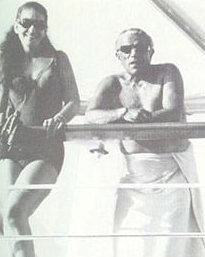In 1946, Ari married Tina Livanos, younger daughter of
Stavros Livanos, the patriarch of the Greek shipping world. Ari
already had made his fortune in Argentina by importing tobacco,
and by the time of his marriage he owned the largest tanker fleet
afloat. Ari and Tina had two children: Christina and Alexsander.
According to the then business practice, Greek and Norwegian
shipowners would purchase a ship by paying hard cash.
Ari, however, came up with a brilliant idea of buying ships on
the strength of the contract he had with
oil companies to transport their products.
Since then, this practice has become standard in ship-buying,
but Ari was among the first ones—if not made it for the
first time. Through his sister’s marriage, Ari later became
the brother-in-law of Stavros Niarchos, another Greek shipowner.
Together the three men formed the most powerful shipping clan in
the world.
In 1953, looking for a base of operations with
a “gold mine”, Ari acquired a
majority stake in SBM—the company that controlled the Monte Carlo
casinos and hotels.
This deal placed Ari in the front row of the world stage, and the
mass media dubbed him as “the man who bought the bank at Monte
Carlo”. Wearing wrap-around black glasses and double-breasted
blue suits, next to his pretty blonde wife, Ari became a favorite
figure for the world’s press.
The publicity helped Ari draw ever bigger names to his famous
cruise ship: Christina. The celebrities include Greta Garbo, John
Wayne, Sir Winston Churchill and then the most prominent diva, his
fellow Greek Maria Kalogeropoulos—well-known as Maria Callas.
In July 1959, Callas and her much-older husband, Battista
Meneghini, boarded the Christina for the fateful cruise with Sir
Winston and Lady Churchill and a few other celebrities.
Somewhere between the Riviera and the Turkish coast it became obvious
to Callas that Ari not only admired her but also suggested to help
her manage her finances.
Once her voice gone, Callas would end up a pauper. This concern
always worried her, and she seemed to find a financial stability in
the prospective relashionship. By the end of the cruise both marriages
went on the rocks as Meneghini suffered from a nervous breakdown
and Tina admitted her love with Reinaldo Herrera.
 The world press followed the most prominent and gossip-providing
couple as Ari and Maria plied the seven
seas in a jet-set fashion. Some paparazzi made a career of chasing the
couple and photographed them everywhere.
The world press followed the most prominent and gossip-providing
couple as Ari and Maria plied the seven
seas in a jet-set fashion. Some paparazzi made a career of chasing the
couple and photographed them everywhere.
After his wedding to Jacqueline Bouvier Kennedy in 1968, however,
his luck suddenly changed.
The Jackie Jinx went to work some evil magic on Ari. Within four years he
lost his son and ex-wife, and seven years later he, too, was dead.
Callas followed him in two years.
From the appearance of Maria Callas to his death,
Ari’s life resembled the eventful life of Odysseus described
in the Odyssey, which Ari loved to read. Circe and Calypso appeared in his life
as if they had stepped into the shoes of Maria Callas and Jackie Kennedy respectively.
If you have read the Gemstone file and
come to believe that Ari might have involved himself in some of those
conspiracies, you naturally wonder what drove him to such an eventful life. To understand this
driving force, you probably have to know the roots of his upbringing.
Aristotle’s father, Socrates, moved with his brothers to Smyrna in Anatolia
(present-day Izmir in Turkey) from a small village inside the country. Although not the oldest of his
brothers, Socrates was the most charismatic and effectively
fulfilled the role as head of the family. They moved to Smyrna
because when a team of engineers and
typographers had visited the village of Moutalasski to build
the new Berlin-Baghdad railway and spoke of the wonderful economic
opportunities in Smyrna.
Socrates Onassis and his brothers became
enchanted by the city’s atmosphere. They recognized
the existence
of the economic opportunities as they witnessed the carpets,
tobacco, cotton, dried-fig, wood, raisins, and other goods that
passed through the port.
After an apprenticeship with
a Jewish merchant near Bohar Benadava, Socrates rented a small
store at
the port and opened an import-export business. He built up
extremely good business and, in a year, moved to a building in
the Han del Gran Visir in Smyrna’s business center. He also
rented another store in a strategic location near the railway and
the port in Daragaz.
Although his business activity eventually spanned diverse
trades, Socrates remained essentially a dealer of tobacco. In the meantime,
all his brothers—Alexander, Homer and Vasili—took part in their
family affairs and their business reputations also expanded.
In fact, Homer and Alexander began to take a keen interest in
politics as their reputation flourished.
Soon thereafter, Socrates
decided to get married, considering the social position he had
already achieved, and to return to the village. He chose to marry
Penelope Dologu, the daughter of a village notable. Not yet 17 years
of age, the bride courageously and intelligently adapted herself to
her duties and gave birth to two sons, Artemide and Aristotle.
At this time around 1900, racially-spurred political strife
in Turkey went well under way. Religious intolerance turned out the core
cause for the 27-year (1895 - 1922) attempt by Turkey to commit genocide upon Christians
(mostly Armenians). During this period, 2 million Armenians lost their lives, often
after prolonged and barbaric torture. As a result, this genocide almost
eliminated Armenia from the map of the world.
The Armenians occupied a long-disputed territory that was fought
over by Persia, Russua and Turkey. Armenia became the scene of turmoil and
opression for centuries. The Turkish Ottoman Empire invaded Armenia in the 15th century and held all of
it by the 16th century.
Although Armenians became successful merchants in Turkey, they always remained an oppressed minority because
of their religion. In April 1909, hundreds of thousands of Armenians were
butchered in the Massacre of Adana.
In the same year, during the nationalist hostility at the hands of the
Turks, a personal tragedy struck Socrates’ family. Ari’s
mother, Penelope, died of
kidney failure, leaving a sad void in the family. Socrates ultimately
remarried, bringing a very good stepmother to Penelope’s sons.
But to Ari, no one would ever love him as his mother Penelope did.
Surrounded by women including the stepmother, the grandmother
Getsemani and the three sisters (two were born from the second
marriage), Ari grew up in a world where religion was an important
obligation.
Although Socrates and his family were not Armenians, they were
devoted Christians. In fact, if it weren’t for the presence of his uncle
Alexander, Ari would have set off towards an ecclesiastic
career. However, his uncle inculcated in him the passion of life,
that taste of struggle and the sense that challenge is highly
respected in a Greek world. These passions dominated the rest of
Ari’s life.
By 1913, the Turks organized mass deportations, and tens of
thousands of Christians had to march across deserts without food
and water. Along the way, the Turkish soldiers whipped, bludgeoned,
bayoneted some of them. They even raped women in front of their
husbands and children. The soldiers then murdered them and tossed
them by the road side.
The Turks, however, did not slaughter all the Christians.
They saved some for slave labor. Twelve thousand of them worked
on the beds of various railroad lines around northeastern Turkey.
Overseen by German officers (World War I was now in progress, and
Turkey was German’s ally), these Christians were rationed
a loaf of bread and some water a day.
Concentration camps of Christians living in tents sprang
up on the countryside. The chronicle of horror seemed endless.
Finally, in 1919, when British troops entered Armenia, an end
to the massacres seemed to be in sight. Before the British troops landed,
however, the Turks made a final genocidal sweep and massacred thousands
of Armenians. The British forces did little to stop these raids, and
the remaining Armenians began to lose hope.
In 1920, the French troops occupied Turkey. in that year alone,
15,000 Armenians lost their lives in Marash. By the middle of 1920, the
Turks stood up against the French and massacred Armenians at will.
Open warfare erupted. Turks burned Armenian homes and businesses as
Armenians burned Turkish mosques. However, the Armenians were
eventually overcome, and the Turkish government confiscated the
houses and other possessions of Armenians.
After World War I, the Greek reoccupation of Smyrna was encouraged.
However, on August 26, 1927, the troops of Kemal Pascia entered and
conquered the region without meeting much Greek resistance. Only
a few days before, Socrates had brought his son Ari (now, 21 years
old) into the office and together they wisely burned the documents
recognizing the political activity of Alexander.
However, his prudence did not keep him from being
arrested and thrown into a concentration camp. The family was
transported to another camp in the island of Lesbos and only Ari
was saved from this travesty. After deceptively lying about his age
and suggesting that he was only 16 years old, Ari convinced the
military figures that he was too young to go to a camp. Ari somehow
found the strength and the necessary inventiveness to organize
an escape and successfully liberated his father from the
concentration camp.





